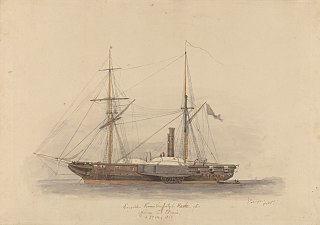
The Russian navy is the naval arm of the Russian Armed Forces. It has existed in various forms since 1696; its present iteration was formed in January 1992 when it succeeded the Navy of the Commonwealth of Independent States.

The Royal New Zealand Navy is the maritime arm of the New Zealand Defence Force. The fleet currently consists of nine ships. The Navy had its origins in the Naval Defence Act 1913, and the subsequent purchase of the cruiser HMS Philomel, which by 1921 had been moored in Auckland as a training ship. A slow buildup occurred during the interwar period, and then perhaps the infant Navy's most notable event occurred when HMS Achilles fought alongside two other Royal Navy cruisers at the Battle of the River Plate against the German ship, Graf Spee, in December 1939.

The South African Navy (SA Navy) is the naval warfare branch of the South African National Defence Force.

The Valour class is a class of frigates built for the South African Navy. Part of the MEKO family of warships, the German shipbuilder Blohm+Voss officially designate the class as the MEKO A-200SAN.

The Hecla class formed the backbone of the Royal Navy's ocean survey fleet from the mid-1960s.

HMS Scott is an ocean survey vessel of the Royal Navy, and the only vessel of her class. She is the third Royal Navy ship to carry the name, and the second to be named after the Antarctic explorer, Robert Falcon Scott. She was ordered to replace the survey ship HMS Hecla.

SAS Amatola (F145) is the first of four Valour-class frigates for the South African Navy by the European South African Corvette Consortium.

SAS Isandlwana (F146) is the second of four Valour-class frigates for the South African Navy built by the European South African Corvette Consortium. SAS Isandlwana was named after the Battle of Isandlwana at a ceremony held in Kiel in December 2002, by Deputy Defence Minister Nozizwe Madlala-Routledge.

SAS Spioenkop (F147) is the third of four Valour-class frigates for the South African Navy built by the European South African Corvette Consortium. She was named by Ms Thandi Modise, the then Chairperson of the Portfolio Committee on Defence, in Hamburg, Germany, on 4 June 2003.

SAS Mendi (F148) is the last of four Valour-class frigates built for the South African Navy by the European South African Corvette Consortium and entered service in March 2007. SAS Mendi was named by Mrs Helena Retief, wife of the (then) Chief of the Navy Vice Admiral Johan Retief.

HMS Herald was a Hecla-class ocean survey ship that served with the Royal Navy during both the Falklands War and Gulf War.

The South African Naval Museum is a maritime museum in Simon's Town, South Africa. It contains collections and artefacts related to the maritime history of South Africa and the South African Navy.

Admiral Flota Sovetskogo Soyuza Gorshkov is an Admiral Gorshkov class frigate of the Russian Navy and the lead ship of the class.

The Pacific Fleet is the Russian Navy fleet in the Pacific Ocean.

The Hydra class were a class of three paddlewheel steam sloops of the British Royal Navy. They saw active service variously in the Baltic during the Crimean War, against Ottoman forces in Syria and against slavers in West Africa. Latterly, Hydra and Hecate were used for surveys in the Mediterranean, the Pacific, Australia and the Atlantic, and thus their names were re-used for the Hecla-class survey vessels in the late 20th century. Two of the classes were broken up after more than twenty-five years of service, and Hecla was sold for commercial use in 1863.

Rizhao (598) is a Type 054A frigate of the People's Liberation Army Navy. She was commissioned on 12 January 2018.
Huainan (123) is a Type 052DL destroyer of the People's Liberation Army Navy.
Kekexilihu (968) is a Type 903A replenishment ship of the People's Liberation Army Navy.

HMSAS Protea was the first hydrographic survey ship used by the South African Naval Service. The ship was laid down as a minesweeper to be named HMS Ventnor in 1917 but was renamed HMS Verwood in 1918 while under construction. She was again re-named and launched as HMS Crozier on 1 July 1919. The vessel was converted from a minesweeper to a hydrographic survey vessel in 1921 and transferred to the South African forces in 1922, where she was commissioned as HMSAS Protea. She served as a survey vessel until 1933 when she was returned to the Royal Navy. Protea was eventually sold by the Royal Navy and renamed MV Queen of the Bay where she went on to operate as a pleasure craft out of Blackpool. She was subsequently sold to the Spanish Navy and renamed Lieutenant Captain Remigio Verdia, and used as supply vessel to run blockades, smuggling supplies to the anti-fascists in Spain during the civil war. She ran aground and sunk off Cartagena in Spain in 1939.

















